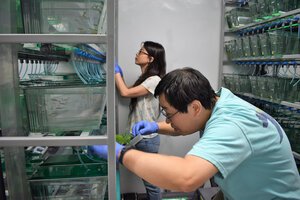Lysosomes are often described as the recycling centers of the cell. They are membrane bound structures within each cell containing digestive enzymes that, among other functions, break down waste products. When those enzymes are not produced due to a genetic mutation, or when the broken down molecules can’t get out of the lysosome, this leads to storage of harmful substances inside the lysosome leading to the aptly named, lysosomal storage disorders.
There are numerous types of lysosomal storage disorders (LSDs), each characterized by the type of lysosomal enzyme that is deficient, and they are of great interest to GGC researchers.

Rich Steet, PhD, GGC’s Director of Research, has spent years studying the function of lysosomes and how their abnormal function results in the clinical features associated with LSDs. While the clinical features vary between different types of LSDs, common findings include coarse facial features, cardiac and skeletal anomalies, learning difficulties, and a shortened life span.
To continue this groundbreaking work, Steet and co-principal investigator and GGC’s Director of Functional Studies, Heather Flanagan-Steet, PhD, have recently secured a four-year renewal of their long-standing grant titled ‘Pathogenic Mechanisms of Lysosomal Disease.’
The grant, which is administered by the National Institute of Neurological Disorders and Stroke (NINDS), a division of the National Institutes of Health (NIH), provides $1.2 million over four years to continue the team’s ongoing work to better understand the mechanisms behind LSDs.
The funding, which is classified as an R01 grant through the NIH, is the original and historically oldest grant mechanism used by NIH. The R01 provides support for health-related research and development that is consistent with the mission of the NIH. An R01 is for mature research projects that are hypothesis-driven with strong preliminary data and are the most competitive of NIH funding sources.
“We are excited by the potential to further unravel the mysteries of lysosomal storage disorders and… that it allows us to expand our work into patient-specific projects here at GGC.” -Rich Steet, PhD
Prior research under this grant focused on a single disorder, mucolipidosis, type II (MLII). The research team has made significant progress in understanding how MLII symptoms develop and they have been able to successfully treat cardiac and skeletal disease manifestations in their zebrafish models. This breakthrough has fostered collaborations to advance treatment studies into a mammalian model with the ultimate goal of developing an effective therapy for patients with this rare disease.

“We are pleased that our prior work on LSDs has been so fruitful and that we are able to continue to move toward better understanding and novel treatment options for families impacted by LSDs,” said Steet.
The primary hypothesis for this new round of funding is that the mechanisms identified in MLII disease are similar across other LSDs, which could lead to novel therapies for several disorders.
The grant renewal will also allow the research team to expand their work on the NUS1 gene which came to the team’s attention through a GGC patient, Chloe.
Chloe was referred to GGC at age 12 to investigate a movement disorder that was causing tremors, seizures, and learning difficulties. Whole exome sequencing was completed, and a variant was identified in the NUS1 gene.
“Chloe’s variant had never been reported before, so we were unsure of its significance,” shared Mike Lyons, MD, GGC’s Director of Clinical Services and Chloe’s clinical geneticist. “We reached out to Dr. Steet’s lab to get their help in understanding if the variant was the cause of her symptoms.”
Through both cellular and zebrafish experiments, researchers were able to confirm that Chloe’s variant was causing her movement issues. They were also able to identify the likely mechanism and a possible therapy.

“Zebrafish that mimic Chloe’s NUS1 variant not only exhibited a movement disorder as seen through abnormal swimming patterns, but they also displayed significant accumulation of cholesterol in their lysosomes,” said Flanagan-Steet. “By using an FDA-approved small molecule, we were able to reduce cholesterol storage in the zebrafish and restore normal swimming behaviors.”
The additional funding through the grant renewal will also help the research team to refine how the storage of cholesterol in the lysosomes occurs in patients with NUS1 mutations and why it leads to the neurological symptoms and movement disorders.
“After completing 13 years of research through this grant funding, we are excited by the potential to further unravel the mysteries of lysosomal storage disorders and identify novel treatments that can help patients like Chloe and the thousands of others who are impacted by LSDs,” said Steet. “While this renewal continues to support our ongoing basic research, we’re thrilled that it also allows us to expand our work into patient-specific projects here at GGC.”
